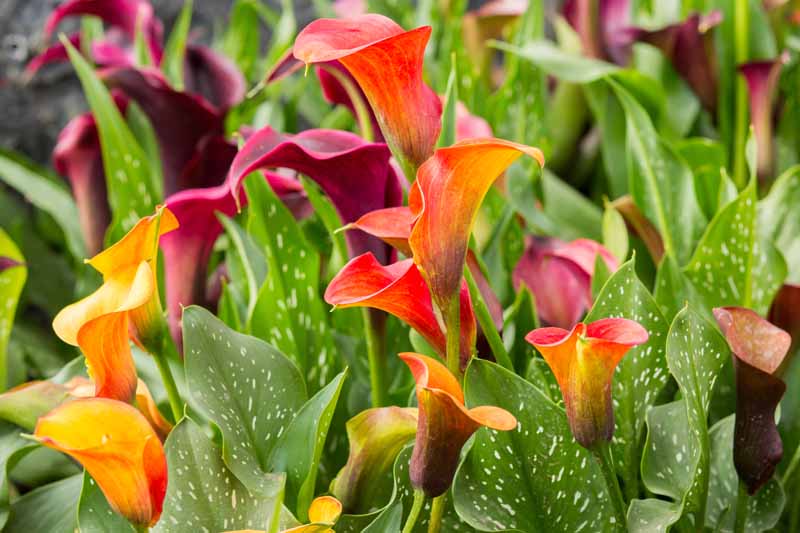When you purchase through links on our site, we may earn an affiliate commission. Here’s how it works.
Calla lilies dont drop petals like many other plants when their flowers are done blooming. The calla flower rolls up into a tube when it starts to die, and the outside of the tube often turns green. These spent blossoms on calla lily plants are done, have no purpose and should be clipped off. Find out how to deadhead a calla lily and why it’s good to remove spent flowers from the stems instead of leaving them there.
Unlike many other flowers, calla lily deadheading wont cause the plant to create more blossoms. Each calla is made to make a certain number of flowers, from as few as one or two to as many as six. Once those blooms have died off, the plant will only show foliage until the following spring. So if it wont create more flowers, why do you deadhead calla lily plants? The reasons are twofold:
Caring for Calla Lilies After Blooming
Calla lilies produce magnificent funnel-shaped blooms on long smooth stems. Their flowers come in a range of colors like white pink, yellow, and purple. Calla lilies bloom for 4-6 weeks in late spring or early summer. But what should you do after these showy blooms fade? Proper aftercare is key to ensure your calla lilies thrive year after year.
Remove Spent Blooms
Unlike some plants where deadheading encourages reblooming calla lilies bloom once per season. However, you should still remove the spent flowers. Calla blooms don’t fall off on their own. The blooms turn green and become tubular as they fade. Snip these unsightly blooms off with pruners. Removing old blooms keeps your plant looking tidy and prevents disease.
Continue Watering
After blooming finishes, continue caring for the foliage. Keep watering your calla lilies while the leaves remain green. Water when the top inch of soil becomes dry. Avoid overwatering, which can lead to root rot. Reduce watering frequency as the leaves start yellowing. Proper moisture prevents leaves from drooping prematurely.
Apply Fertilizer
Feed your calla lilies with a balanced liquid fertilizer every 2-4 weeks after blooming ends. The nutrients support the plant while it sends energy to the rhizomes. Stop fertilizing once the leaves start turning yellow. Fertilizing late in the season can spur growth that is prone to frost damage.
Monitor for Pests
Inspect calla lily leaves and flowers periodically for signs of infestation. Aphids, thrips, and mites can attack lilies. Treat any pests you spot with horticultural oil or insecticidal soap sprays. This protects the plant’s health going into dormancy.
Cut Back Leaves
In mid to late summer, the calla lily’s leaves will turn yellow or brown and become dry. Once the foliage declines, use sterilized pruners to trim the leaves back near the base of the plant. Removing dead leaves reduces the risk of diseases.
Dig Up Rhizomes
After the first frost, dig up the underground rhizomes. Carefully loosen the soil and lift out the rhizomes. Remove any remaining foliage. Gently brush off dirt but don’t wash the rhizomes. Washing removes the protective skin coating.
Dry and Store Rhizomes
Place the dug rhizomes in a dry, well-ventilated area for 1-2 weeks. Turn them periodically. This allows them to cure properly. Once dried, put the rhizomes in peat moss or vermiculite. Store in a cool place around 50-60°F over winter. The dry medium prevents rotting.
Repot Container Plants
For calla lilies grown in pots, bring the containers indoors before frost hits. Place in a sunny spot and keep watering lightly until the leaves die back. Repot in fresh soil every 2-3 years in early spring.
Water Sparingly
Check rhizome storage medium periodically and lightly water if it becomes completely dry. Some moisture prevents shriveling. Avoid overwatering, which can quickly lead to rot and disease.
Discard Damaged Rhizomes
Inspect overwintering rhizomes occasionally. Discard any that show signs of rot or damage. Diseased rhizomes can spread problems when replanted.
Replant in Spring
In early spring after the threat of frost has passed, replant calla lily rhizomes outdoors. Dig holes the same depth as the rhizome and 2 feet apart. Place rhizomes with the sprouting eyes up and cover with soil.
With proper aftercare and overwintering, your calla lilies will return healthier than ever each growing season! The above steps help nurture the rhizomes so they survive dormancy to produce stunning blooms year after year.

How to Deadhead Calla Lily
The information on deadheading calla lilies is a simple set of instructions. Your aim is to remove the blossom, as well as to make the plant more attractive. Cut the stem off close to the base with garden shears or scissors. Make sure that the bare stem doesn’t stick out through the leaves. However, leave a short stem near the plant’s base. This is also the best way to remove the flowers from calla lilies while still leaving the plant healthy if you want to use them in bouquets.
CALLA LILIES AFTER BLOOM CARE
FAQ
Should calla lilies be cut back after flowering?
How do you save calla lilies for next year?
Do calla lilies bloom more than once?
Are you supposed to deadhead calla lilies?
- The Ultimate Guide to Growing Strawberries in Raised Beds - August 8, 2025
- No-Dig Garden Beds: The Easiest Way to Grow a Beautiful Garden - August 6, 2025
- How to Protect and Preserve Wood for Raised Garden Beds - August 6, 2025
